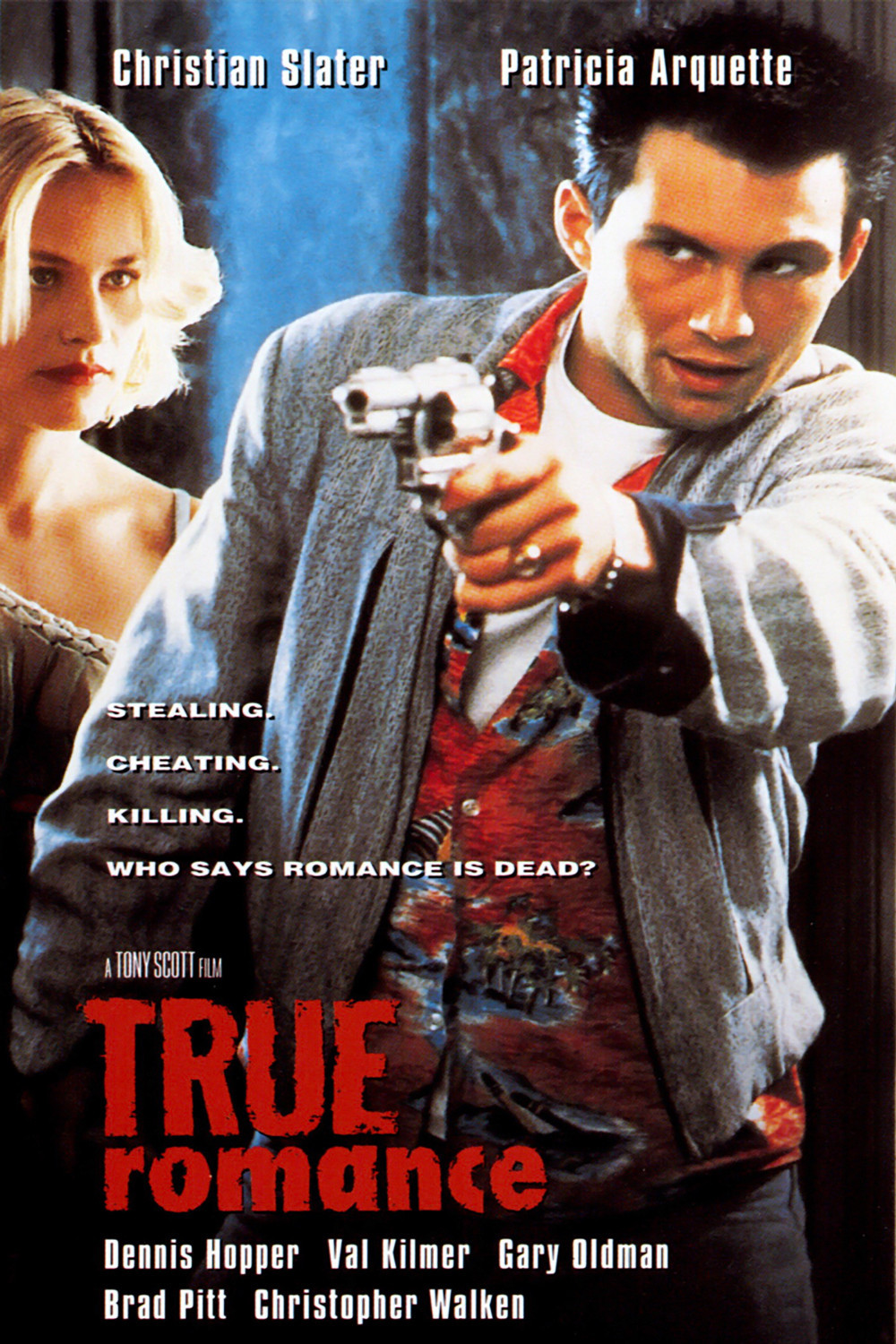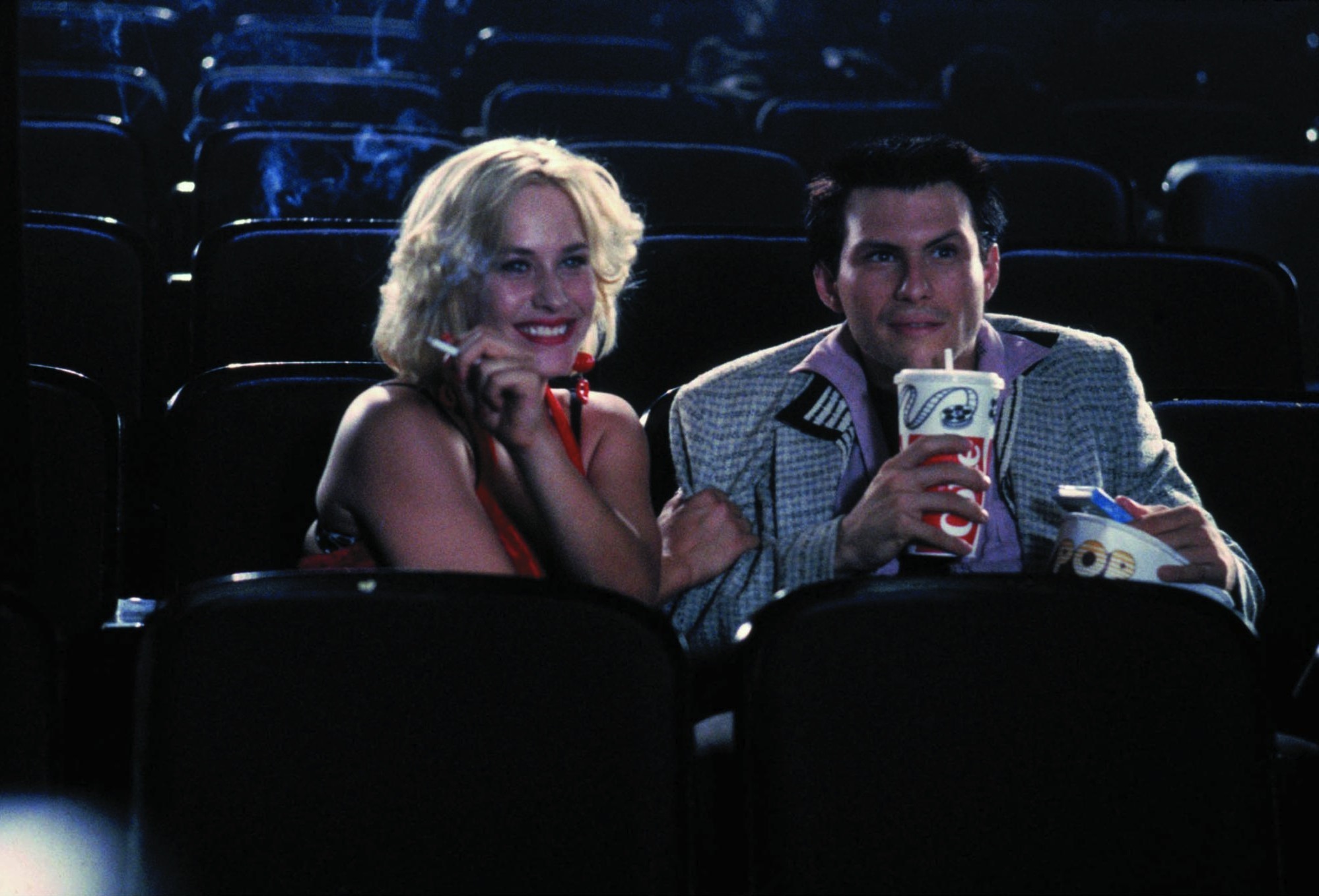How incredibly fitting it is that in True Romance, the Quentin Tarantino-scripted crime thriller, true love is found at the movies. After unsuccessfully trying to pick-up a hot blonde at a bar, comic store clerk Clarence (Christian Slater) prepares to celebrate his birthday alone at a movie theater showing a Street Fighter triple feature. In walks Alabama (Patricia Arquette), a tall drink of water in a leopard-skin coat and a red dress Saran-wrapped to her body. Out of all the empty seats in the theater, Alabama chooses to sit next to Clarence, and after a whirlwind 24 hours, the two are madly in love and married. If this sounds too good to be true, it is: Alabama is a call girl hired to bed Clarence, she has a gun-toting pimp with mob ties, and Clarence is now the owner of a suitcase stuffed with countless bags of cocaine.
Directed by Tony Scott and released in 1993, True Romance is one of a handful of films written but not directed by Tarantino. “True Romance is probably my most personal script,” Tarantino wrote in his introduction to the published screenplay. The first script he wrote and only the second to be released as a major motion picture, True Romance is a fascinating glimpse into the embryonic talents of a young filmmaker. (Or perhaps, a glimpse into a strange period of time when Bronson Pinchot would have a bigger role in a Tarantino film than Samuel L. Jackson and Brad Pitt.) For better or for worse, all the Tarantino trademarks are here: Mexican standoffs, Pam Grier movie references, racial slurs, and arterial sprays of blood.
Thinking about Clarence and Alabama, it occurs to me that True Romance is perhaps the most straightforward love story in Tarantino’s filmography. In Pulp Fiction, Butch and Fabienne’s romance, full of bubbly talk of potbellies and blueberry pancakes, feels incongruous with the rest of the film’s criminal coolness. The attraction between Jackie Brown and Max Cherry is all the more tender because it’s unconsummated and almost unspoken. In Death Proof, the strange flirtation between Arlene and Stuntman Mike climaxes not with the lap dance she gives him, but when Mike sadistically murders her with his car. The flashbacks to The Bride’s relationship with her mortal enemy Bill are clouded by Bill’s paternalism towards her, like the college professor who romantically pursues his student partly because he wants to mold her into a younger version of himself. Django and Broomhilda’s love is nothing less than the story of Siegfried and Brunhilda, myth and legend personified. In comparison, Clarence and Alabama’s “boy meets girl, boy marries girl, boy shoots her pimp” love affair is as simple as the starry-eyed comics that give True Romance its title.
The plot is pure wish fulfillment fantasy, the kind a young screenwriter can rarely get away with. Specifically, it’s a very male fantasy. This is a movie dedicated to every twentysomething guy who ever wished he could wow a girl by explaining Sonny Chiba movies to her, or romance her with a copy of Sgt. Fury and His Howling Commandoes. Does Alabama want to see what Spider-Man #1 looks like? Of course she does, because all of her interests must coincide with Clarence’s. When Clarence asks her what she does and where she’s from, her answers say nothing: “I don’t remember…I don’t know.” Alabama has literally stepped out of Clarence’s dreams; her past self is unimportant.
Viewing the film for the first time, I kept waiting for the other shoe to drop: it does, sort of, when Alabama confesses that she was a call girl hired by Clarence’s boss to make his birthday really memorable. A-ha, but wouldn’t you know it, she’s fallen in love with Clarence anyway and wants to run away with him. It’s not that Clarence is unappealing—Christian Slater imbues him with the same darkly comic energy that lured Winona Ryder into a high school killing spree—but come on, I say, as a woman watching True Romance in 2016. Come on.
Thankfully, Tarantino’s ability to write female roles would grow exceptionally—compare Alabama to Mia Wallace in Pulp Fiction, released just a year later in 1994. As played by Uma Thurman, Mia, a failed actress and a mobster’s wife, is funny, cool, and surprisingly vulnerable. I believe that Mia Wallace is a real person—I can’t believe in Alabama. That’s not to put any of the blame on Patricia Arquette’s shoulders, however. Late in the film, Alabama immolates and shoots the attacking mobster played by James Gandolfini. Bloody, triumphant, and clad only in a bra and impossibly tight pants, Alabama finally seems to gain an identity of her own, and it’s the moment in which we can see the modern, polished Tarantino being born, like a chick poking its way out of its shell.
But the film’s biggest moment of pure fantasy—its happy ending—is fascinating to watch because it’s not the ending Tarantino wrote. It’s maybe impossible to watch True Romance without wondering how Tarantino would have directed it. This isn’t a slight against Tony Scott, as the man who directed The Hunger and Top Gun certainly knows how to make a stylish film. But, early in his career, Tarantino did not have the clout to prevent producers and directors from altering his script. Gone is the nonlinear structure so essential to Tarantino’s later works and the original ending is hacked off for a happy epilogue in which Clarence and Alabama ride into the sunset and have a son.
 In the scripted ending, Clarence is killed in the final mob/police shootout, catching a bullet to the face and dying in Alabama’s arms. This is the most honest ending to the story, not because it adds one more body to Tarantino’s bloody pile, but because it feels the truest. Clarence and Alabama are not career criminals, having accidentally stumbled into a mess much bigger than them and already gotten Clarence’s father killed. (Permit me parentheses to sing the praises of Dennis Hopper as Clarence’s father, whose final showdown with Christopher Walken’s crime lord is the best scene in the film and gives us the fantastic line, “I’m the Antichrist. You got me in a vendetta kind of mood.”) Eventually, their luck runs out. The fantasy ends. Tony Scott’s ending prevents reality from intruding on their fantasy because, apparently, he liked the two crazy kids too much to separate them. (If you want to know what Arquette and Slater performing the original script would be like, hopefully you were one of the few who saw them perform a live reading last year.)
In the scripted ending, Clarence is killed in the final mob/police shootout, catching a bullet to the face and dying in Alabama’s arms. This is the most honest ending to the story, not because it adds one more body to Tarantino’s bloody pile, but because it feels the truest. Clarence and Alabama are not career criminals, having accidentally stumbled into a mess much bigger than them and already gotten Clarence’s father killed. (Permit me parentheses to sing the praises of Dennis Hopper as Clarence’s father, whose final showdown with Christopher Walken’s crime lord is the best scene in the film and gives us the fantastic line, “I’m the Antichrist. You got me in a vendetta kind of mood.”) Eventually, their luck runs out. The fantasy ends. Tony Scott’s ending prevents reality from intruding on their fantasy because, apparently, he liked the two crazy kids too much to separate them. (If you want to know what Arquette and Slater performing the original script would be like, hopefully you were one of the few who saw them perform a live reading last year.)
True Romance was Quentin Tarantino’s first script, and possibly his least essential—a self-indulgent fantasy ironically made even more self-indulgent by studio interference. It’s a love letter to every geek who dreams of making it big with a femme fatale on one arm and a copy of Spider-Man #1 in the other. But for Quentin Tarantino fans, the film is also an intriguing look into a screenwriter’s awkward growth spurts and a promise of greater things to come. And True Romance is, as its title suggests, the purest love story he’s yet written. Ain’t love grand?


